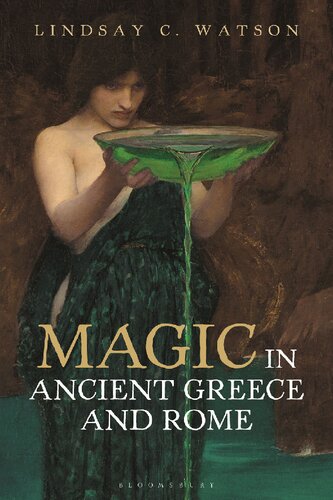Product desciption
Magic In Ancient Greece And Rome Lindsay C Watson by Lindsay C. Watson 9781788312974, 9781788312981, 9781350108974, 178831297X, 1788312988, 1350108979 instant download after payment.
Parting company with the trend in recent scholarship to treat the subject in abstract, highly theoretical terms, Magic in Ancient Greece and Rome proposes that the magic-working of antiquity was in reality a highly pragmatic business, with very clearly formulated aims – often of an exceedingly maligant kind.
In seven chapters, each addressed to an important arm of Greco-Roman magic, the volume discusses the history of the rediscovery and publication of the so-called Greek Magical Papyri, a key source for our understanding of ancient magic; the startling violence of ancient erotic spells and the use of these by women as well as men; the alteration in the landscape of defixio (curse tablet) studies by major new finds and the confirmation these provide that the frequently lethal intent of such tablets must not be downplayed; the use of herbs in magic, considered from numerous perspectives but with an especial focus on the bizarre-seeming rituals and protocols attendant upon their collection; the employment of animals in magic, the factors determining the choice of animal, the uses to which they were put, and the procuring and storage of animal parts, conceivably in a sorcerer’s workshop; the witch as a literary construct, the clear homologies between the magical procedures of fictional witches and those documented for real spells, the gendering of the witch-figure and the reductive presentation of sorceresses as old, risible and ineffectual; the issue of whether ancient magicians practised human sacrifice and the illuminating parallels between such accusations and late 20th century accounts of child-murder in the context of perverted Satanic rituals.
By challenging a number of orthodoxies and opening up some underexamined aspects of the subject, this wide-ranging study stakes out important new territory in the field of magical studies.
In recent work on the magic of ancient Greece and Rome there has been a tendency to discuss the subject in abstract, distinctly theoretical terms. Such an approach risks obscuring a key feature of ancient magic: that it is a highly pragmatic art, exhibiting clearly articulated purposes and outcomes. Keeping this goal-focused pragmatism squarely in view, and calling into question a number of established scholarly positions, this study examines various arms of Graeco-Roman magic, united for the most part by their malign character.
These are, sex magic, the inducing of irresistible passion in another party – often in a startlingly violent way; the inscribing of curse tablets for purposes that were invariably harmful, and the important recent discoveries within the field that force us to examine anew our understanding of these exceedingly sinister documents; the question of whether ancient magicians engaged in human sacrifice for divinatory purposes, as ancient sources claim, and the illuminating typological resemblances between such charges and the lurid tales spawned by modern so-called satanic panics; and the gendered construction of the witch in Greek and Roman literature and the frequent debunking of hyperbolical claims to miraculous transformative powers by the revelation of risible ineffectuality.
Two further chapters examine the subject of magic and herbs and the employment of animals in magic. Here it is argued that, while the operative principles and rituals governing the use of botanical and zoological vehicles may seem on the face of it bizarre, they are informed by a naturalistic logic of their own, irrespective of whether they serve curative or destructive ends.


